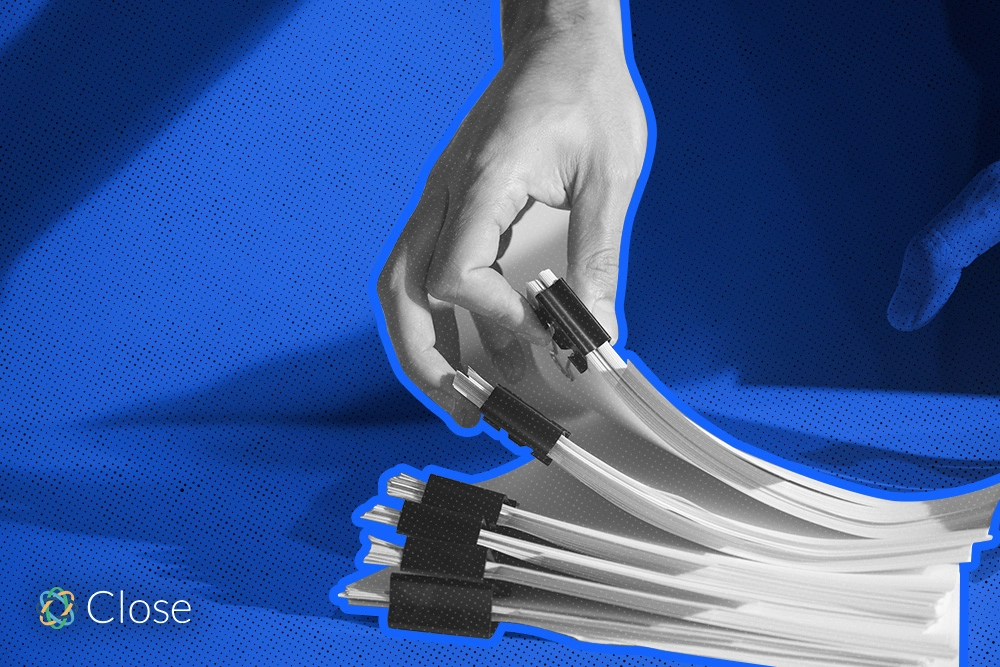
Want to know something crazy?
There are 585,000 tech companies in the United States. And guess what—just about all of them want to sell your business another life-changing gadget or earth-shattering software.
Unfortunately, the worldwide economy is on the fritz. Inflation is sky-high, and most experts predict a recession of some kind in the next 6 to 12 months. That means you probably can't keep paying for your company's bloated technology stack. You may need to tighten your belt.
This is actually a good thing. Shelling out for 53 different SaaS solutions is expensive. And navigating between all of these tools on a daily basis is time-consuming. You need to find a way to streamline your tech, while maintaining your current sales process. Can it be done?
Absolutely! In this article, I'll tell you why tech stack consolidation is beneficial and how to do it in simple steps. That way you can get back to crushing department initiatives ASAP.
The Benefits of Tech Stack Consolidation
I won't lie; consolidating your tech stack will take time and effort.
The question is, will it be worth it in the end? That's for you to decide. To help you decide, you need to understand the numerous benefits you'll experience.
Here are four key advantages to tech stack consolidation:
It Saves Your Team Time
According to the Harvard Business Review, it takes the average office worker a little over two seconds to switch from one app or website to another.
That doesn't seem like much, until you realize that said workers are switching between apps and websites 1,200 times every day. The result? 40 minutes lost, per employee, per day. And that assumes they don’t get distracted while switching over.
It gets worse. The same HBR article claims that switching between apps and websites like this is "cognitively taxing." Doing so "increases the brain's production of cortisol (the primary stress hormone), slows us down, and makes it harder to focus." Ugh…
Tech stack consolidation will help eliminate inefficiencies caused by app switching and boost productivity. Think of how many more deals your team will be able to close.
Looking for the secret ingredients to successful sales? Check out our article on sales productivity tools for insights.
It Lowers Expenses
The average company spends $2,623 a year on SaaS products—per employee.
How many sales reps do you manage? 5? 10? 20? The cost of these tools adds up fast. Tech stack consolidation will help you put a bunch of green back into company coffers.
What if you could invest in a single app for pipeline management, automation, forecasting, and other sales tasks, instead of three separate solutions? CRM platforms like Close make this a reality. You just have to find the right tools for your needs. (More on this below.)
It Improves Communication
How many messaging apps does your company use? Let me guess: Slack for quick queries, email for detailed responses, Zoom for face-to-face interactions… Did I miss anything?
If your team's "communication ecosystem" includes more than one app, you may want to rethink your strategy. It costs your company a lot of money, as we just discussed.
But it's also reinforcing data silos. Information gets logged away on certain platforms, never to be seen again. Why? Because nobody can remember which app they used to share the data. It's a serious problem—one that tech stack consolidation can easily solve.
It Enhances Data Security
There were 1,802 data breaches in the U.S. last year, affecting 422 million individuals.
All of those new technologies you've purchased for your sales team? They could put your company at risk. Tech stack consolidation limits the number of targets on your back.
I love SaaS tools and fancy gadgets as much as the next guy. But let's be honest. You probably don't need all of the apps your sales team subscribes to. Eliminating a few of them will give cybercriminals fewer opportunities to steal company and personal data.
 |
A Step-by-Step Guide to Consolidating Your Tech Stack
Tech stack consolidation is obviously beneficial. If you're ready to take the plunge and optimize your department's technology suite, follow this simple, seven-step guide:
1. Audit Your Tech Stack
Start by assessing your current tech stack. Which off-premise software tools do you use? Which SaaS providers actually provide the services you need? Also, make sure to check how many seats you have on each plan–many SaaS companies charge by seat, so if users include past employees or people who don’t use the tool, you could be paying more than you need to.
There's probably a lot more in your tech stack than you realize. After all, the average company uses 110 different SaaS apps. Yes, you read that right: 110. Yikes!
To be clear, don't start deleting software and canceling service agreements yet. All you need to do right now is determine the apps your sales team uses on a regular basis, the benefit each one provides, and the amount of money you spend to access these tools.
You can take a metaphorical machete to your tech stack later, once you've determined which apps to keep. Patience you must have, my young padawan.
2. Identify Redundancies
You've taken the time to audit your current tech stack. It made you want to barf, thinking about the hundreds (thousands?) of dollars your department spends on software. But you took a deep breath, and now you're ready to move on. It's time to identify redundancies.
Look through your current technology suite and pinpoint apps that accomplish similar things.
For example, you might pay for a CRM solution and a sales enablement tool. Do you need both? Not if you only use the enablement tool to distribute content to prospects. Your CRM should be able to handle this just fine. The same goes for CRM and email platforms.
CRMs like Close include fully-featured email marketing suites. You probably don't need to pay for Mailchimp or Constant Contact, too, unless your company's marketing team wants them.
This reminds me: get feedback from other people in your company. Just because you and your reps don't use a tool, doesn't mean it's worthless. It might be designed for other teams.
3. Prioritize the Right Tools
At this point, you've assessed your current tech stack; learned which apps your company pays for, what they do, and how much they cost; and identified redundancies.
Great work. Now it's time to decide which apps to keep and which to give the boot. To make this process easier, ask yourself these three questions:
- Do we really need this app? To be honest, the answer is probably no. Other than a proven CRM and, maybe, a team communication app, the rest of the tools in your company's tech stack are probably non-essential. But don't get rid of them yet.
- Does the benefit of this app outweigh the cost? An app may be non-essential, but that doesn't make it worthless. Assess the value of each app. If the benefit of having it is greater than its costs, consider keeping it. If not, it should probably get the ax.
- Do other departments agree with my assessments? Remember, other departments use tools that yours doesn't. Don't banish apps because your reps don't understand their proper use cases. Consult with other team leaders to see which tools they need.
One more thing: make sure to account for staffing shortages.
As mentioned earlier, the economy has seen better days. A recession may be on the horizon. Unfortunately, your company may need to lay off a few employees to weather the coming storm. Try not to ditch apps that you may need in the future, when your team is smaller.
Tools that include automation functionality, for example, will help you get more done in less time—even if your team has fewer members. And, on a more positive note, these tools may help your current team handle a larger workload without burning out.
4. Develop a Consolidation Plan
Now that you know which apps you need, you can create a consolidation plan. That's just a fancy way of saying, "We're going to keep paying for these apps, not those ones."
There are a few ways to go about this:
You can get rid of every solution that is non-essential. You may end up using spreadsheets instead of a CRM, have zero access to automation, and lose out on sales because your reps can't remember who they need to follow up with, which seems like a bad idea.
But, hey, it's your tech stack. You make the decision you think is best for your department.
Or, you can eliminate all point solutions, i.e., tools designed with one specific purpose in mind, and invest in a single platform that will allow your team to do multiple things. This will probably help your department save money, and you won't have to worry about pesky integrations. But you might have to give up important, business-boosting features.
Or, my personal favorite, you can invest in a few tools that do multiple things. Then connect them so that your entire tech stack operates as one unit. It might look something like this:
- Close: Close is a CRM that helps sales teams organize customer data, communicate with prospects, manage pipeline, forecast future sales, and more.
- Slack: Slack is a popular communication tool that sales teams can use to speak to each other, host video calls with prospects, and distribute files.
- DocuSign: DocuSign is a document management and e-signature tool that sales teams can use to create contracts and reach binding agreements.
- Centus: Centus is a website content translation and localization tool, which ensures meticulous content adaptation, aiming to enhance user experience and extend market presence through linguistic accuracy and cultural relevance.
- ChartMogul: ChartMogul is an analytics tool that allows users to get deep insights into the health of their businesses with metrics like MRR, ARR, Churn, and LTV.
This is just an idea, of course. Your tech stack will probably look a lot different. But it does illustrate my point: a few well-chosen apps can go a long way.
 |
5. Get Feedback from Your Team
You've created a solid consolidation plan. It's time to put it into action, right? Not quite…
Get feedback from your team before you play whack-a-mole with your tech stack. They're the ones that will have to use the tools you've selected on a daily basis. Make sure they like them.
I suggest reading software reviews on sites like G2 and Capterra as well. You might as well consult your connections on social media sites like LinkedIn, too.
What do they have to say about the apps you've chosen? The last thing you want to do is invest in a few tools, hoping they can each do multiple things, then realize that they can't handle your team's current workflows. Talk about a major letdown.
6. Migrate Company Data and Train Users
Your next task? Migrating data and training users to use your new solutions.
Now that you know which software applications will be in your tech stack, you need to cancel old services, sign up for new ones, and transfer everything over.
This process may feel long and tedious. But try to remember all of the benefits you'll achieve: your team will become more productive, you'll save a boatload of money, your staff's communication will improve, and you won't be as susceptible to cybersecurity threats.
Once you've made the switch, you need to teach your reps to use your new tools. This doesn't have to be a herculean task. Most software apps offer thorough training via YouTube videos, live webinars, and blog posts. Dive into them to learn the ins and outs of each app.
7. Monitor and Adjust When Necessary
Finally, monitor your new and improved tech stack to make sure it works for your team.
Do your reps enjoy the tools you've chosen? Are you still able to close deals at a consistent clip? Can you cut away other solutions? Or did you cut too many of them already?
These are all important questions. Take time to really assess your new tech stack to make sure it works for your team. If it doesn't, make the necessary adjustments. All of the effort you expend now will be worth it in the end. You just have to soldier on and muster through.
Do More with Less
Here's the bottom line: your bloated tech stack is damaging your company. It costs a ton of money. It reduces employee productivity. And it opens you up to cyber-attacks.
You can solve all of these problems by committing to tech stack consolidation. Follow the seven-step process above to eliminate tools your reps don't use, and/or purchase new tools that do multiple things, giving you way more bang for your buck.
Speaking of tools that do multiple things, have you tried Close yet? Our popular CRM platform will help organize prospect and existing customer data, supercharge your reps' phone call workflows, design full-fledged email marketing campaigns, forecast future results, and so much more.
Sign up for a free 14-day trial of Close today to see if it's worthy of your company's tech stack.









